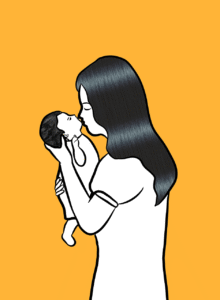Understanding Baby Crying Patterns
Normal Crying Patterns
– Newborns routinely cry 1 to 4 hours per day
– Crying serves several important purposes:
– Communicates needs (hunger, discomfort, attention)
– Helps shut out overwhelming sensations
– Releases tension
– Crying often increases at 2-3 weeks of age, peaks around 6-8 weeks, and typically decreases by 3-4 months
– Many babies have predictable fussy periods, often in late afternoon or evening
– After crying episodes, babies may appear more alert and then sleep more deeply
Types of Cries
Different cries may indicate different needs:
– Hunger cries: rhythmic, repetitive pattern
– Pain cries: sudden, high-pitched, intense
– Fatigue cries: whiny, nasal quality
– Boredom/attention cries: intermittent, less intense
– Cries become stronger, louder, and more varied as babies mature
– Parents often learn to distinguish their baby’s specific cry patterns
Colic
– Affects approximately 1 in 5 babies
Characterized by:
– Intense crying for 3+ hours per day
– Episodes occurring at least 3 days per week
– Pattern continuing for 3+ weeks
– Crying often occurs at the same time each day (typically late afternoon/evening)
– Physical signs include pulling legs up, passing gas, and appearing in pain
– Typically:
– Starts when baby is 2-4 weeks old
– Improves around 8 weeks
– Resolves by 3-4 months (though can last until 6 months)
– Possible causes include:
– Heightened sensitivity to stimulation
– Immature nervous system/inability to self-console
– Digestive system development
– Food sensitivities (less common)
Effective Soothing Techniques
The 5 S’s Method (Dr. Harvey Karp)
1. Swaddling: Wrapping baby snugly in a thin blanket to provide womb-like security
2. Side/Stomach Position: Holding baby on their side or stomach (only while awake and supervised)
3. Shushing: Using white noise or gentle “shhhh” sounds that mimic womb sounds
4. Swinging: Providing gentle, rhythmic motion (rocking, swaying)
5. Sucking: Offering pacifier or clean finger to satisfy natural sucking reflex
Additional Soothing Strategies
– Movement-Based Techniques:
– Rocking in a rocking chair
– Walking while carrying baby
– Using a baby carrier or sling
– Gentle bouncing on an exercise ball
– Car rides (motion and engine noise)
– Stroller walks
– Sound-Based Techniques:
– White noise machines
– Heartbeat sounds
– Gentle music or singing
– Humming
– Running water sounds
– Vacuum cleaner or fan noise
– Touch-Based Techniques:

Photo by Tilixia-Summer on Pixabay
– Skin-to-skin contact
– Infant massage
– Gentle back or chest patting
– Stroking head or face
– Warm bath (if baby enjoys it)
– Environmental Adjustments:
– Reducing stimulation (dimming lights, quieting environment)
– Maintaining comfortable temperature
– Checking for clothing discomfort (tags, tight spots)
– Ensuring proper feeding techniques to reduce gas
Addressing Specific Causes of Crying
– Hunger: Feed baby, watching for early hunger cues like lip-smacking
– Discomfort: Check diaper, clothing, temperature
– Overtiredness: Create calming bedtime routine, watch for sleep cues
– Overstimulation: Move to quieter, dimmer environment
– Gas/Digestive Issues: Proper burping, bicycle leg movements, tummy time
– Reflux: Hold upright after feeding, consult pediatrician if severe
Dietary Considerations
– For breastfeeding mothers:
– Consider eliminating potential sensitivity triggers (dairy, caffeine, spicy foods)
– Monitor for 2-3 weeks before determining effectiveness
– Reintroduce foods one at a time to identify triggers
– For formula-fed babies:
– Consult pediatrician about trying different formulas
– Consider specialized formulas for sensitive tummies if recommended
Self-Care for Parents
Managing Caregiver Stress
– Take breaks when feeling overwhelmed (put baby in safe place like crib)
– Use calming techniques like deep breathing
– Tag-team with partner or support person
– Remember crying is not a reflection of parenting skills
– Track patterns to identify triggers and effective solutions
– Understand that some crying is normal and not harmful
When to Seek Help
– Baby has fever or seems ill
– Crying is excessive and inconsolable beyond typical patterns
– Baby isn’t eating, sleeping, or developing normally
– Parent is feeling overwhelmed, depressed, or unable to cope
– Crying is accompanied by vomiting, diarrhea, or other concerning symptoms
– Consult your healthcare professional if you have concerns
Resources for Parents
– Pediatrician or family doctor
– Lactation consultants (for feeding-related issues)
– Postpartum doulas
– Parent support groups
– Infant mental health specialists
– Crisis hotlines for overwhelmed parents
Key Takeaways
1. All babies cry, and increased crying in the first few months is normal
2. Responding promptly to crying builds trust and security
3. Different soothing techniques work for different babies
4. Keeping calm helps soothe baby more effectively
5. Self-care for parents is essential
6. Crying typically decreases significantly after 3-4 months
7. Seek medical advice if concerned about excessive crying
Sources
1. American Academy of Pediatrics – HealthyChildren.org (2025) – Responding to Your Baby’s Cries
2. Central Coast Pediatrics (2025) – Crying and Your Baby: How to Calm a Fussy or Colicky Baby
3. Dr. Harvey Karp – The 5 S’s for Soothing Babies
4. The Mother Baby Center (2024) – The 5 S’s to soothe and comfort baby
5. Kansas Children’s Service League (2024) – The Ultimate Guide to Soothing a Crying Baby




